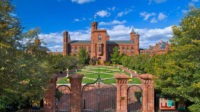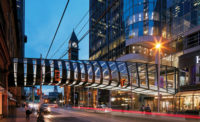The Smithsonian Institution is making historic plans for both its newest and oldest museums. It just awarded a design programming contract for the National Museum of African American History and Culture, slated to open in 2015, and it’s considering an unprecedented public-private redevelopment of its crumbling Arts and Industries Building, which debuted in 1881 as America’s first “National Museum.”
On October 30, the Smithsonian announced that Freelon Bond, an association of design firms Davis Brody Bond and The Freelon Group, will conduct a $4 million, 18-month programming study for the new African-American museum. The architects held their first meeting with Smithsonian officials this week to discuss design needs.
“This can be more than a building,” says Philip G. Freelon, FAIA, principal of The Freelon Group. “It can be a catalyst for the country to address the issue of race in a positive and constructive way.” Touted as the final museum building on the National Mall, already home to a dozen others, the institution will rise on a five-acre site wedged between the Washington Monument and the National Museum of American History. During the colonial era and afterward, a slave-owning plantation and slave markets occupied the land.
Just across the mall, the Smithsonian is seeking a team to redevelop its Arts and Industries Building. Originally constructed for the Centennial Exhibition in 1876, the polychrome brick building was designed by German immigrant Adolf Cluss. Although it is listed on the National Register of Historic Places, the building was added to the National Trust for Historic Preservation’s list of the nation’s 11 Most Endangered Places in 2006 after safety concerns and funding deficits forced its closure two years earlier. This month Smithsonian officials published a request for qualifications seeking a private or public group that can create a plan for preservation and redevelopment.
“The Smithsonian welcomes concepts that combine typical private sector redevelopment goals with educational, scientific, cultural, technological or other like-minded elements,” the RFQ says. But that same 14-page document also nixes so-called “undignified” re-use as a nightclub, hotel, or similar function. Smithsonian spokesperson Linda St. Thomas says that it will cost an estimated $55 million to $65 million simply to update the building’s ornate shell to satisfy current code requirements. Developers can tour the 180,000-square-foot structure on November 28 and December 12. The deadline for submitting a proposal is January 7.
The cash-strapped Smithsonian, which receives roughly 70 percent of its funding from the federal government, is considering this unprecedented arrangement at the behest of Congress. The Senate Rules and Administration Committee, which oversees the Smithsonian, has called for a hearing on December 12 to discuss a recent report by the U.S. Government Accountability Office, which detailed a $2.5 billion maintenance backlog at the institution.






Post a comment to this article
Report Abusive Comment